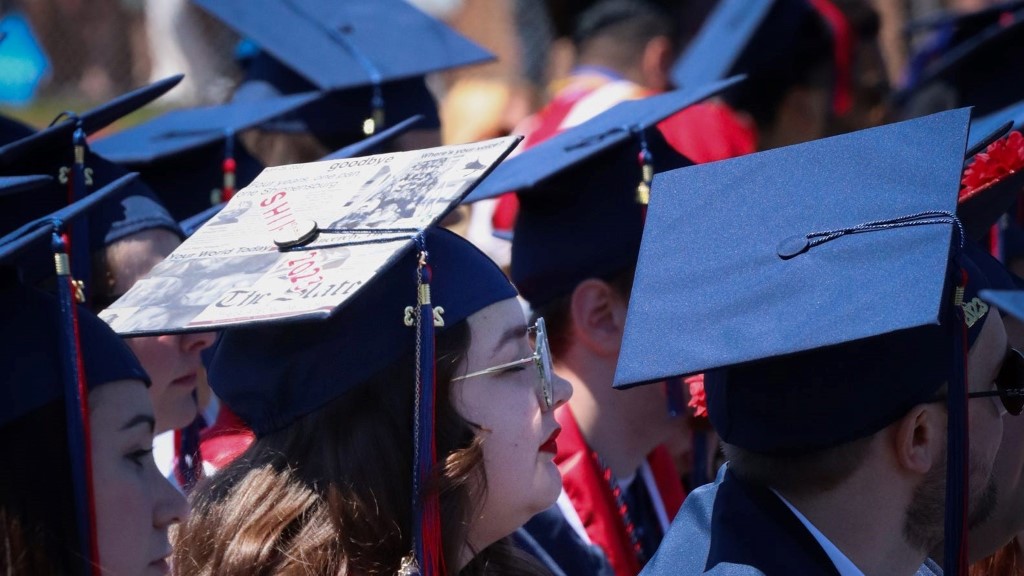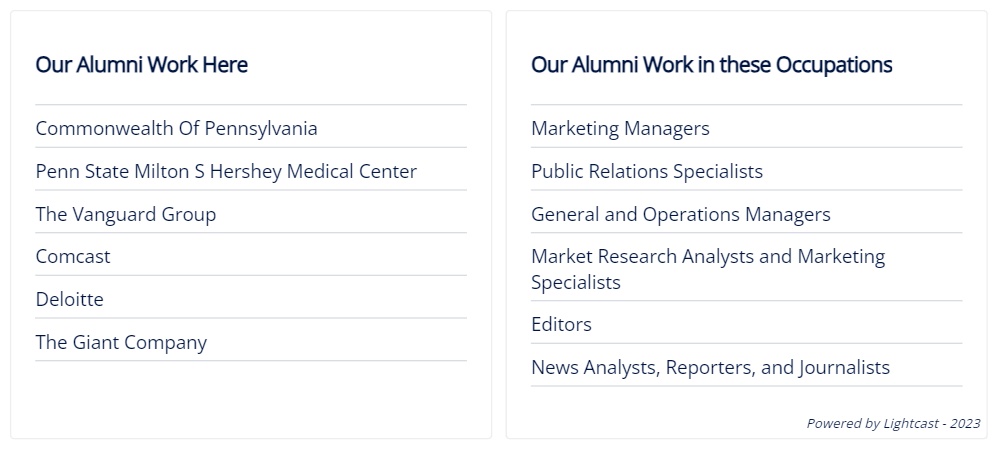Student Success

At Shippensburg, maximizing our students' success is a key goal of the university. There are four areas where student success is tracked and measured; they include student enrollment, new student persistence and graduation rates, degree confirmations, and alumni employment.
Enrollment
The Department of Communication, Journalism, and Media is home to about 7% of Shippensburg University's College of Arts and Sciences. The program offers multiple professional concentrations that students can earn including Public Relations, Broadcast Media Production, Journalism, and Visual Media.
| Programs | Fall 2018 | Fall 2019 | Fall 2020 | Fall 2021 | Fall 2022 |
|---|---|---|---|---|---|
| Electronic Media | 83 | 84 | 85 | 56 | 27 |
| Print & Online Media | 36 | 30 | 31 | 19 | 13 |
| Public Relations | 88 | 77 | 67 | 64 | 42 |
| Broadcast Media Production | - | - | - | 13 | 29 |
| Journalism | - | - | - | 5 | 17 |
| Visual Media | - | - | - | 9 | 19 |
| Total (Distinct) | 207 | 191 | 183 | 166 | 147 |
Between the Fall 2020 and Fall 2021 terms, the Communication, Journalism, and Media program was reorganized in an effort to adapt the program curriculum and coursework to the changing workforce needs and skillsets that are required for our students to be successful after graduation. The Electronic Media and Print & Online Media concentrations were reorganized into Broadcast Media Production, Journalism, and Visual Media, which is the reason for zero enrollments in the new programs prior to the Fall 2021 term and why Print & Online Media and Electronic Media saw steep declines after Fall 2020.
Persistence Rates
Student persistence rates measure over periods of time, the percentage of an original group of students who have either been retained, meaning they have returned and are still enrolled, or have graduated. These student groups are typically defined by the academic term when the student first enters Shippensburg and usually only include new full-time freshmen students. Persistence rates are then tracked yearly, providing a measure of the overall academic success of students from a specific group, or cohort, as they progress through their academic careers at Ship with 2nd Year, 3rd Year, and 4th Year persistence rates being the most commonly used measures. For example, of the 25 new students who entered the program in the Fall 2021 term, 72% (18 students) persisted to their second year at Ship.
| Cohort Term of Entry | Original Cohort Size | 2nd Year Persistence Rate | 3rd Year Persistence Rate | 4th Year Persistence Rate |
|---|---|---|---|---|
| Fall 2017 | 37 | 75.7% | 70.3% | 67.6% |
| Fall 2018 | 36 | 77.8% | 69.4% | 69.4% |
| Fall 2019 | 35 | 85.7% | 65.7% | 60% |
| Fall 2020 | 21 | 66.7% | 61.9% | - |
| Fall 2021 | 25 | 72% | - | - |
Persistence rates for students in the Communication, Journalism, and Media programs have traditionally been at or above the university average, however, the Fall 2020 cohort of new students saw a large decline in 2nd Year persistence, as was the case across the university as a whole. In fact, this was the trend nationally and can be attributed to the changes and disruptions to the typical educational experience caused by the COVID-19 pandemic. This temporary decline can be considered an outlier as evidenced by the Fall 2021 cohort and the shift back towards higher pre-pandemic persistence rates.
Graduation Rates
Student graduation rates differ from persistence rates in that only the percentage of students who have graduated over time is measured. Graduation rates are also tracked yearly with 4th Year, 5th Year, and 6th Year graduation rates being the most commonly used measures of student success.
| Cohort Term of Entry | Original Cohort Size | 4th Year Graduation Rate | 5th Year Graduation Rate | 6th Year Graduation Rate |
|---|---|---|---|---|
| Fall 2014 | 52 | 45.1% | 51% | 52.9% |
| Fall 2015 | 37 | 59.5% | 64.9% | 64.9% |
| Fall 2016 | 37 | 48.6% | 56.8% | 56.8% |
| Fall 2017 | 37 | 45.9% | 59.5% | - |
| Fall 2018 | 36 | 55.6% | - | - |
Degrees Conferred
Degree confirmations, or degrees awarded, is a measure of the total number of degrees earned by graduates in a given academic year. This differs from graduation rates in that it includes all students in the program who earn a degree, such as internal and external transfer students who transfer into the program, not just the students who started in the program as full-time students. The table below shows the total number of Bachelor's degrees awarded for the Communication, Journalism, and Media programs over the past five years, along with the average final GPA of those.
| 2017-2018 | 2018-2019 | 2019-2020 | 2020-2021 | 2021-2022 | |
|---|---|---|---|---|---|
| Degrees Awarded | 68 | 72 | 48 | 48 | 42 |
| Avg. Final GPA | 3.06 | 3.03 | 3.02 | 3.11 | 3.20 |
Employment
The CJM department performs research and outreach to track the success of its alumni and through these efforts, data is collected from a number of sources including alumni feedback and survey information, as well as third-party data that is originally sourced from online professional social media profiles, job search sites, etc. This information is used to better understand the success of our alumni after they enter the workforce and to solicit feedback for opportunities to adjust the program so graduates are fully prepared to meet the demands of today's changing workforce.
Post-graduate Alumni Survey
One source of alumni information comes from the CJM alumni survey. The survey asks questions that collect feedback on different aspects of the program such as courses that were most beneficial, experiences that best prepared alumni for their careers and overall rating of the department. The most recent iteration of this survey was done in 2023 and had 103 total responses. The results of the final questions related to experiences with the CJM department are shown below.
The data in the chart above reflects the overall theme of the responses from the survey, which were generally positive toward the program and department. Several graduates highlighted unique experiences that they had in the program that were determining factors for preparing them for success in their professional careers.
...Diversity in the media; communications law and programming management were all courses that taught me vital information...
...Shippensburg's campus media programs were outstanding during my time there. I was highly active with WSYC and, looking back, I'm very grateful for how involved the faculty advisers were in these programs...Additionally, the department places a high emphasis on the value of internships, and this has proven to be most valuable for my career...
...SUTV absolutely prepared me for a career in media production allowing me to work independently and as a group to problem solve and be creative...
...PRSSA and working with clients helped prepare me for the workforce and gave me the experience I needed to find my first job out of college...
...My experience at The Slate was incredible. I learned a lot early on there, considering that I was a department editor by my sophomore year. Those experiences actually put me ahead in my class, to the point where I was helping classmates along in the Editing class I took...
Top Job Occupations and Places of Employment
CJM alumni can be found in a number of occupations in the industry across a wide variety of employers. Based on online profile data, the top occupation is Marketing Managers, followed by Public Relations Specialists. Some of the top employers include Fortune 500 companies such as Comcast, The Vanguard Group, and Deloitte.

Job Demand Outlook
The job demand for occupations commonly filled by CJM graduates is expected to grow over the next five years. The graph below shows the expected job demand for occupations related to Marketing Managers, Public Relations Specialists, Editors, & News Analysts, Reporters, and Journalists.

